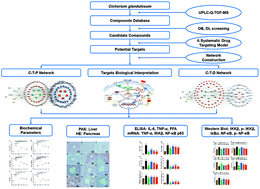Systematic investigation of the mechanism of Cichorium glandulosum on type 2 diabetes mellitus accompanied with non-alcoholic fatty liver rats†
Abstract
Cichorium glandulosum(CG) can treat various diseases with multiple targets effectively. It has been widely used in folk medicine to treat nonalcoholic fatty liver disease (NAFLD) as well as type 2 diabetes mellitus (T2DM). However, the active compounds and underlying mechanisms of CG on T2DM accompanied with NAFLD (T2DM-NAFLD) remain unclear. In this study, a systems pharmacology method was used to explain the pharmacology mechanism of CG for treatment of T2DM-NAFLD. Twenty four main compounds were detected by UPLC-Q-TOF-MS, of which 13 showed favorable pharmacokinetic profiles. We demonstrated with target fishing and pathway analysis that CG has protective effects on T2DM-NAFLD, probably through the regulation of 88 targets and 86 pathways. Forty nine targets were related to T2DM, and 39 were related to NAFLD, while 27 targets, primarily involved in insulin resistance and inflammation were common to T2DM and NAFLD related pathways. A NF-κB signaling pathway was chosen to validate the impacts of CG on T2DM-NAFLD because CG can ameliorate T2DM-NAFLD by regulating the NF-κB signaling pathway according to animal experiments. These findings systematically interpreted the active compounds and mechanism of the efficiency of CG for treating T2DM-NAFLD. This study not only laid a basis for understanding the active compounds and action mechanism of CG, but also provides a reference for a study of the mechanism of a herbal medicine for the treatment of multiple diseases.



 Please wait while we load your content...
Please wait while we load your content...